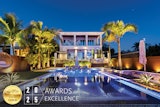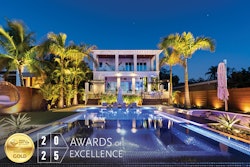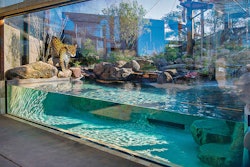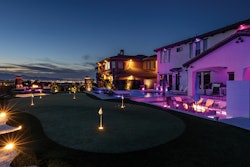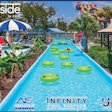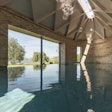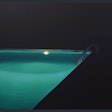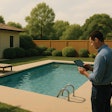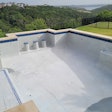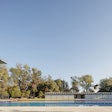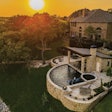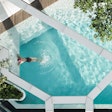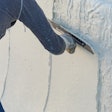Earlier this week, we posted Part I of Eric Herman's two-part series on the history of the swimming pool industry. Below is the conclusion, beginning in the post-war era.
MODERN INNOVATIONS
The post-war era gave rise to a wide range of innovations that would advance the pool industry and in many cases define residential swimming pools for much of the remainder of the 20th century.
For example, manufacturing pioneer and inventor, Ray Rude created the first aluminum diving board from an airplane wing in 1946. Other important innovations included the introduction of time clocks in the late '50s, underwater pool lights, easy-to-use test kits, natural gas pool heaters, and automatic pool cleaners, the origins of which can be traced back to as early as 1907.
Pool designs also expanded during this period. One of the prime examples was the advent of the infinity or vanishing edge. (One of the first vanishing edge designs was utilized in the "Stag Fountain" at the Palace of Versailles in the early 1600s.) Swimming pools with water-in-transit effects began appearing in luxury homes in France in the 1950s. Opinions about the origin of and inspiration for the vanishing edge vary. Some art historians have said that terraced rice patties of Southeast Asia were the original inspiration, others point to water flowing over dam walls in reservoirs as another.
Whatever their origin, in 1956, visionary contemporary architect and Frank Lloyd Wright protégé, John Lautner, completed a home in Los Angeles commonly known as Silvertop, which featured what many believe is the first vanishing edge pool in the U. S. Lautner would continue blazing trails with his designs that often included wildly creative integration of pools and home architecture.
The vanishing edge was for years considered exotic, expensive and too tricky for most pool builders and didn't become popular until the late 1980s. Today, the vanishing edge and its cousin the deck-level perimeter overflow are iconic mainstays of custom pool design.
Throughout the '50s and '60s, so-called mid-century modern pools became popular in affluent areas such as Palm Springs, Calif., where the backyard pool is almost inseparable from the region's signature contemporary home design.
During that period, pioneering designers including Roberto Burle Marx, Ricardo Legoretta, Luis Barragan and Lawrence Halprin continued to push the creative envelope of landscape and aquatic designs the world over. Their direct influence lives on today in the works of many of the most inventive aquatic architects.
THE SEXY '70s
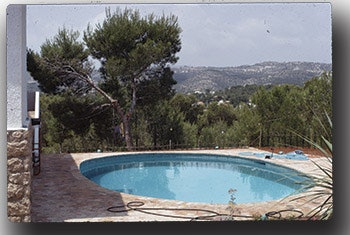
That following year, another of the world's most influential pools was completed at the Playboy Mansion West in Holmby Hills, Calif. Designed by architects Suzanne and Ron Dirsmith for publishing maven Hugh Hefner, the pool features the iconic stone grotto and a lagoon-style design. It has since become one of the most photographed pools in the world and has served as inspiration for countless more "modest" installations.
One of the biggest developments of the 1970s was the appearance of in-ground gunite attached spas, along with the archetypal wooden hot tub, hot-water vessels added an entirely new sensual dimension to the concept of the backyard oasis.
Far less sensational, but no less influential, in 1975, Peter Bajka, considered the father of pool automation and founder of Compool, created the first-ever electronic control system, an innovation that ushered in the modern era of electronic pool and spa control technology.
Yet another innovative wave generally associated with the 1970s involved the use of artificial rock. Also known as faux rock, techniques for using concrete to create formations that appear realistic date back to Germany prior to the turn of the 20th century originally developed for zoological exhibits. Large high profile applications of artificial rock started emerging in the U.S. mid-century, perhaps the most famous being the replica of the Matterhorn at Disneyland, along with other massive applications at other amusement parks and zoos.

The '70s also saw the emergence of so-called "alternative sanitizers." In 1974 the Journal of the American Waterworks Association published research indicating that chlorination led to the formation of potentially harmful byproducts, including trihalomethanes, haloacetic acids, nitrosamines and others. As a result, environmental groups such as Green Peace began spreading information driving anti-chlorination public sentiment.
Worries about chlorination helped foster the rise of non-chlorine sanitizers including ozone, biguanides and mineral ionizers. Some of these technologies quickly fell by the wayside, but others survived and remain an important industry segment.
'80s Style
The 1980s brought the onset of social change driven by technology, including the rise of the personal computer, the spread of cable television and meteoric popularity of video games. During this time of rapid technical expansion, consumers demanded greater and greater levels of excitement. That trend was reflected in the aquatics world with the emergence of the waterpark.
There's considerable debate about what should be identified as the first-ever water park. According to the World Water Park Association, however, the credit goes to George Millay who established Wet-N-Wild in Orlando, Fla., in 1977. Earlier in his career, Millay was also credited for coming up with the idea for Seaworld. The water park concept was almost immediately successful; water parks seemed to spring up around the world almost overnight. By the end of the '80s, most major cities in the U.S. featured some form of waterpark.
Although generally considered tangential to the pool and spa industry, the presence of waterparks with their variety of dynamic interactive features - speed slides, spray pads, play structures, lazy rivers and wave pools - began influencing consumer desires associated with pools. Many community pools began incorporating waterpark features to attract visitors, while high-end residential projects also began being built with interactive features.

The concept came to the U.S. when Pebble Technology was formed to introduce Pebble Tec to the Arizona market in 1988. It didn't stay confined there for long as the concept spread rapidly throughout the U.S., due both to the product's durability compared to traditional plaster and its alternative appearance and texture. In the years following the introduction of Pebble Tec an entire industry segment emerged offering a range of products based on the exposed aggregate concept, forever changing the appearance of residential pools.
Another Australian invention came to America in the mid-80s: saltwater chlorination. Ironically the idea caught on largely because consumers were seeking a chlorine alternative. Similar to how chlorine products are manufactured in a factory, "saltwater pools" use an electrolytic process to turn sodium chloride, salt, into free available chlorine. Homeowners no longer needed to purchase, transport, store or add chlorine to their pools, convenient and cost-saving advantages that continue to drive the popularity of saltwater pools.
MODERN ASSIMILATION

Although safety had always been a concern for the industry, the '90s saw rapidly increasing public outcries about child drowning, which in turn led to the introduction and popularization of a range of safety products, some of which had already been around for years. Safety covers, pool fences and alarms played roles in addressing safety concerns. Heated debate about safety-driven ordinances became commonplace as the pool industry struggled to contend with growing pressure from consumers, safety advocates and gov't regulators.
The '90s also saw the introduction of computer-driven design systems developed specifically for aquatic design and customer presentation alongside the meteoric rise of AutoCad, the computer-aided design platform that has come to dominate design and engineering work across the spectrum of architectural and manufacturing industries.
By the turn of the millennium, the pool industry was undergoing a self-image crisis. Although still popular with consumers and commercial property owners, demand for more varied outdoor experiences, coupled with rapidly rising real estate values, drove a wave of creative expansion often aimed at overcoming the stigmatized public face of the industry.
Working in the industry's favor, aging baby boomers increasingly sought the safety, comfort and convenience of spending recreational time and money at home. The concept of the stay-at-home vacation or "stay-cation" prompted designers to think beyond the water's edge. Outdoor kitchens, entertaining areas, fire features, sound systems and increasingly complex landscape designs took hold, resulting in a new era of creative design expansion.
Pools themselves continued to evolve in sophistication and expense. A prime example emerged during the early 2000s in the form of all-tile pools. Using tile as a pool finish was nothing new; in fact tile mosaics were one of the signatures of Roman baths. In the modern era, all-tile pools still existed but were extremely rare, reserved mainly for the ultra-wealthy. For the most part, tile applications for swimming pools were limited to the familiar waterline tile.
The status quo changed rapidly at the start of the 21st century with the introduction of a spectrum of tile products, including jewel-like glass tile mosaics. Improvements in tile application techniques and products facilitated the growth in popularity of both ceramic and glass tile across a more inclusive economic spectrum. Although still a luxury product, glass tile pools are now far more common.
BACK TO NATURE
For the purposes of this discussion (and, yes, the author did deliberately choose not to discuss suction entrapment and VGB) we'll conclude with an innovative idea that is only recently begun to catch on in the U.S. - the natural swimming pool.
Originated in 1985 by Austrian Peter Pietrich, founder of Biotop and followed shortly thereafter by Germany's Bionova, natural swimming pools replace traditional filtration and chemical treatment a set of natural processes collectively known as the "wetlands" effect.
The concept harnesses processes found in nature by filtering water through "regeneration zones" pond-like areas where aquatic plants and microorganisms remove contaminants and consumer harmful pathogens. Though widely used in bio-filtration common to ponds and water gardens (another related industry that saw tremendous growth in recent years,) it was considered foreign to swimming pools, at least in the U.S.
Since their introduction, natural swimming pools have become widely accepted throughout much of Europe, including use in large commercial pools. Only recently have they begun to show up in the U.S. with first clutch of systems being installed within the past two years, although more are reportedly in the works.
Comments or thoughts on this article? Please e-mail [email protected].
Want more history? Check out the history of the hot tub industry.





















